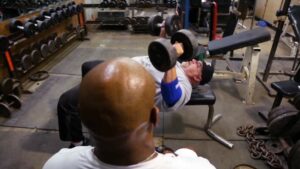If you’re a gym enthusiast and you think you want to increase weights because your muscles got used to lightweights, then here’s a study based on real evidence on when or when not to start lifting light weights vs heavyweights. Keep in mind that lightweights will NOT always build muscle as heavyweights because your muscles need hypertrophy to stimulate new muscle tissue.
Aside from the aesthetic benefits, weight lifting offers innumerable health benefits, including a faster metabolism, increased bone density, better functioning in all of your daily tasks, injury prevention, and so much more.
But if you’re new to weight lifting, you might not know where to begin when choosing it comes to deciding on the amount of weight. You probably know that it’s essential to keep yourself challenged, but should that be with light weights or heavyweights? It turns out that what type of weight you choose depends on your goals, the specific exercise you are performing, and personal preference.
“While there’s no specific weight range for light or heavyweights, what you consider to be light or heavy can be gauged by how challenging the weight is to move through the range of motion for the exercise you choose. Naturally, bigger body parts and movements that require multiple joints, such as squats and deadlifts, will lift heavier weights with more ease than smaller body parts like your biceps and triceps”.
To get to the bottom of the benefits of lifting light weights vs heavyweights (and which is better suited for your personal fitness goals), we asked physical therapists Dr. Amy Schultz and Dr. Joscelyn Shumate Bourne.
The Benefits of Light Weights
Using light weights helps with endurance strength training. “Lightweights are beneficial for lean muscle since there is an aerobic cardio component to the exercise,” says Shultz. Lightweights may also offer an advantage for beginners just learning the ropes.
Starting your weight lifting journey with lighter weights helps you focus on form, making sure it’s perfected before getting into the more heavy and challenging weights that require an excellent form to prevent injuries.
Other benefits, according to Bourne, include:
- Easier to find equipment for a workout
- Improve technique a form
- Build lean muscle mass
- Build muscle strength
- Move through a greater range of motion
- Build endurance strength
The Benefits of Heavy Weights
Heavier weights are typically for strength or power training. The difference between the two depends on the speed of the movement. “This is beneficial for increasing the amount of weight you would be able to lift (strength) and explosiveness required by things like jumping or sprinting (power),” says Shultz.
Heavyweights, meaning ones that challenge you with fewer repetitions, are excellent for building strength and muscle. Other benefits, according to Shumate Bourne, include:
- Lower repetitions need to be performed
- An efficient way to build muscle strength
- Higher calorie burn from more effort
- Sends hormonal signal to your body to grow muscle
When to Use Light Weights
Lightweights typically require you to perform more repetitions and sets. This is because, with a less challenging weight, more time-under-tension is necessary to tire out the muscles.
Lightweights are helpful if your goal is to increase muscular endurance. “This rep scheme complements endurance-based activities such as running a marathon. Lightweights can also be appropriate on days between heavier lifts or to target smaller postural muscles such as the rotator cuff muscles of the hip and shoulder,” says Bourne.
How to Use Light Weights
When using light weights, you’ll want to use a high number of repetitions. For muscular endurance, that means 12 or more reps. For building muscle size (hypertrophy), perform 8-10 reps. However, these are just guidelines, and beginners can see excellent results from performing 12 to 15 repetitions on any exercise.
The weight you choose should still be heavy enough to challenge you to the point you are almost near failure—meaning you cannot complete another repetition—by the end of your set. Once you can perform the exercise with the same weight for the maximum number of reps, you should switch to a heavier weight. This technique is called progression, and you need to do it to keep seeing results.
When to Use Heavy Weights
Use heavier weights when your goals include running faster, jumping higher, running uphill, or wanting to improve overall explosiveness.
The human body tends to get comfortable when you always work in the same rep range. Changing up the rep ranges and sets using a technique called periodization helps keep your body guessing. Periodization is simply planning changes to your reps and sets every so often.
How to Use Heavy Weights
“Heavier weights will cause the lifter to fatigue faster; therefore, the rep and sets will more often look like four sets of four to six repetitions or two to three sets of four repetitions,” explains Bourne.
Shultz recommends heavier weights for compound exercises. “When lifting with heavier weights, expect to perform more compound movements such as a deadlift, power clean, or a dipping drive to an overhead press, instead of using single muscle groups such as triceps extension,” says Bourne.
While you can certainly use light weights for compound exercises, such as squats, deadlifts, rows, bench press, and shoulder press, you will want to cycle these phases of using light weights with using heavyweights to keep seeing results. As well, these large muscle groups will take a very long time to fatigue if you stick to lightweights. Using heavy weights will exhaust the muscles faster and more effectively.
The Conclusion
There are benefits to using both light and heavy weights, no matter your goals. Switching up the weights you use and how you structure your workouts with reps and sets helps keep your body adapting and changing. Muscular adaptations lead to progress, so you can see and feel all of that hard work pay off.

For more news and updates, follow IFBNewsfeed.Org on Facebook, Twitter, and Instagram.






